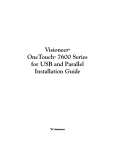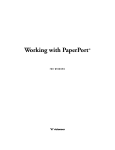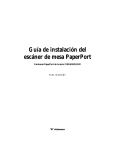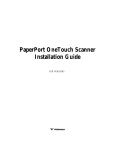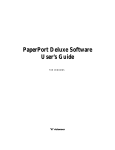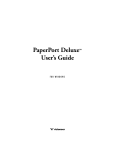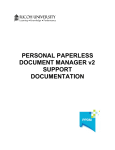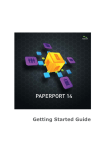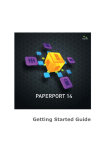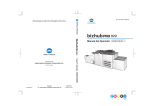Download Visioneer PROOCR100 Installation guide
Transcript
Visioneer USB Flatbed Scanner Installation Guide ® 3100 & 6100 USB™ Series FOR WINDOWS COPYRIGHT INFORMATION PaperPort 5.3 Software for Windows. Copyright ©1999 Visioneer, Inc. All rights reserved. Reproduction, adaptation, or translation without prior written permission is prohibited, except as allowed under the copyright laws. AnyPort, AutoFix, AutoLaunch, Visioneer® FormTyper, MicroChrome, PaperEnable, PaperLaunch, PaperPort, PaperPort Deluxe, PaperPort ix, PaperPort Links, PaperPort mx, PaperPort OneTouch, PaperPort PowerBar, PaperPort vx, PaperPortation, PaperPort Strobe, PaperPort 3000, PaperPort 3100, PaperPort 3100B, PaperPort 3100 USB, PaperPort 6000, PaperPort 6000A, PaperPort 6000B, PaperPort 6100, PaperPort 6100USB, ScanDirect, SimpleSearch, SharpPage, Visioneer Pro OCR 100, and Visioneer are trademarks of Visioneer, Inc. PaperPort, Visioneer® Visual Explorer, and the Visioneer logo are registered trademarks of Visioneer, Inc. Microsoft is a U.S. registered trademark of Microsoft Corporation. Windows is a trademark of Microsoft Corporation. TextBridge is a registered trademark of Xerox Corporation. ZyINDEX is a registered trademark of ZyLAB International, Inc. ZyINDEX toolkit portions, Copyright © 1990-1998, ZyLAB International, Inc. All Rights Reserved. All other products mentioned herein may be trademarks of their respective companies. Information is subject to change without notice and does not represent a commitment on the part of Visioneer, Inc. The software described is furnished under a licensing agreement. The software may be used or copied only in accordance with the terms of such an agreement. It is against the law to copy the software on any medium except as specifically allowed in the licensing agreement. No part of this document may be reproduced or transmitted in any form or by any means, electronic or mechanical, including photocopying, recording, or information storage and retrieval systems, or translated to another language, for any purpose other than the licensee’s personal use and as specifically allowed in the licensing agreement, without the express written permission of Visioneer, Inc. Part Number: 05-0367-100 Restricted Rights Legend Use, duplication, or disclosure is subject to restrictions as set forth in contract subdivision (c)(1)(ii) of the Rights in Technical Data and Computer Software Clause 52.227-FAR14. Material scanned by this product may be protected by governmental laws and other regulations, such as copyright laws. The customer is solely responsible for complying with all such laws and regulations. Visioneer’s Limited Product Warranty If you find physical defects in the materials or the workmanship used in making the product described in this document, Visioneer will repair, or at its option, replace, the product at no charge to you, provided you return it (postage prepaid, with proof of your purchase from the original reseller) during the 12-month period after the date of your original purchase of the product. THIS IS VISIONEER’S ONLY WARRANTY AND YOUR EXCLUSIVE REMEDY CONCERNING THE PRODUCT, ALL OTHER REPRESENTATIONS, WARRANTIES OR CONDITIONS, EXPRESS OR IMPLIED, WRITTEN OR ORAL, INCLUDING ANY WARRANTY OF MERCHANTABILITY, FITNESS FOR A PARTICULAR PURPOSE OR NON-INFRINGEMENT, ARE EXPRESSLY EXCLUDED. AS A RESULT, EXCEPT AS SET OUT ABOVE, THE PRODUCT IS SOLD “AS IS” AND YOU ARE ASSUMING THE ENTIRE RISK AS TO THE PRODUCT’S SUITABILITY TO YOUR NEEDS, ITS QUALITY AND ITS PERFORMANCE, IN NO EVENT WILL VISIONEER BE LIABLE FOR DIRECT, INDIRECT, SPECIAL, INCIDENTAL OR CONSEQUENTIAL DAMAGES RESULTING FROM ANY DEFECT IN THE PRODUCT OR FROM ITS USE, EVEN IF ADVISED OF THE POSSIBILITY OF SUCH DAMAGES. All exclusions and limitations in this warranty are made only to the extent permitted by applicable law and shall be of no effect to the extent in conflict with the express requirements of applicable law. FCC Radio Frequency Interference Statement This equipment has been tested and found to comply with the limits for the class B digital device, pursuant to part 15 of the FCC Rules. These limits are designed to provide reasonable protection against interference in a residential installation. This equipment generates, uses and can radiate radio frequency energy and if not installed, and used in accordance with the instructions, may cause harmful interference to radio communications. However, there is no guarantee that interference will not occur in a particular installation. If this equipment does cause harmful interference to radio or television reception, which can be determined by turning the equipment off and on, the user is encouraged to try and correct the interference by one or more of the following measures: • Reorient or relocate the receiving antenna. • Increase the separation between the equipment and receiver. • Connect the equipment into an outlet on a circuit different from that to which the receiver is connected. • Consult the dealer or an experienced radio/TV technician for help. This equipment has been certified to comply with the limits for a class B computing device, pursuant to FCC Rules. In order to maintain compliance with FCC regulations, shielded cables must be used with this equipment. Operation with non-approved equipment or unshielded cables is likely to result in interference to radio and TV reception. The user is cautioned that changes and modifications made to the equipment without the approval of manufacturer could void the user's authority to operate this equipment. This device complies with part 15 of the FCC Rules. Operation is subject to the following two conditions: (1) This device may not cause harmful interference, and (2) this device must accept any interference received, including interference that may cause undesired operation. TA B L E O F C O N T E N T S Welcome . . . . . . . . . . . . . . . . . . . . . . . . . . . . . . . . . . . . . . . . . . . . . . 1 What’s in the Box . . . . . . . . . . . . . . . . . . . . . . . . . . . . . . . . . . . . . . . 1 What You Need . . . . . . . . . . . . . . . . . . . . . . . . . . . . . . . . . . . . . . . . . 2 Getting the PaperPort User’s Guide . . . . . . . . . . . . . . . . . . . . . . . . . . 2 The Scanner . . . . . . . . . . . . . . . . . . . . . . . . . . . . . . . . . . . . . . . . . . . 3 Getting Help . . . . . . . . . . . . . . . . . . . . . . . . . . . . . . . . . . . . . . . . . . . 4 Installing the PaperPort Software . . . . . . . . . . . . . . . . . . . . . . . . . . . . 4 Connecting the Scanner to Your Computer . . . . . . . . . . . . . . . . . . . . 5 Setting Up the Scanner . . . . . . . . . . . . . . . . . . . . . . . . . . . . . . . . . . . 7 Scanning an Item . . . . . . . . . . . . . . . . . . . . . . . . . . . . . . . . . . . . . . . . 8 Using the Visioneer Scan Manager . . . . . . . . . . . . . . . . . . . . . . 10 Adjusting Scanner Settings . . . . . . . . . . . . . . . . . . . . . . . . . . . . . . . . 11 Selecting a Predefined Scanner Setting . . . . . . . . . . . . . . . . . . . 12 Customizing a Scanner Setting . . . . . . . . . . . . . . . . . . . . . . . . . 13 Scanning in Color . . . . . . . . . . . . . . . . . . . . . . . . . . . . . . . . . . . 14 Adjusting the Brightness and Contrast . . . . . . . . . . . . . . . . . . . 15 Selecting the Area of the Item You Want to Scan . . . . . . . . . . . 16 Cleaning the Scanner Glass . . . . . . . . . . . . . . . . . . . . . . . . . . . . . . . 17 PaperPort 3100 & 6100 USB Scanner Specifications . . . . . . . . . . . 18 iii iv TABLE OF CONTENTS WELCOME Congratulations on purchasing your Visioneer USB flatbed scanner. With your scanner, you can quickly scan paper documents and color photos to place their electronic images on your computer. WHAT’S IN THE BOX Before starting the installation, check the contents of the box to make sure that all parts are included. If any items are missing or damaged, contact the dealer where you purchased the scanner. PaperPort USB Scanner Software CD Installation Guide USB cable Power cord Note: The CD also includes the PaperPort User’s Guide, the manual for the PaperPort software. You can print a copy from the CD to your printer. VISIONEER USB FLATBED SCANNER INSTALLATION GUIDE 1 2 VISIONEER USB FLATBED SCANNER INSTALLATION GUIDE WHAT YOU NEED To use the scanner and software, you need the following: • • • • • • IBM PC (or 100-percent compatible) Pentium or equivalent Microsoft Windows 98 One available Universal Serial Bus (USB) port on your computer 16 megabytes (MB) or more of available internal memory (RAM) 35 MB of free hard disk space A VGA or SVGA monitor. Recommended settings for your monitor are as many colors as possible—High Color (16-bit), True Color (24-bit or 32-bit). Set the resolution to at least 800 by 600 pixels. To set your monitor’s colors and resolution, open the Windows Control Panel, double-click Display, and then click the Settings tab. • A CD-ROM drive GETTING THE PAPERPORT USER’S GUIDE The CD also includes your PaperPort Getting Started Guide and PaperPort User’s Guide. These guides provide more detailed information about PaperPort’s features. Please see the CD to view these guides. You can also print these guides from the CD. THE SCANNER THE SCANNER 1 Document cover 2 Document pad 3 Glass 4 Reference frame 5 Button 6 USB port 7 Power jack 1 Document cover. Close the document cover after placing items on the scanner glass. 2 Document pad. Helps to secure the document in place on the scanner glass. 3 Glass. Place items face down on top of the glass, in the upper left corner. 4 Reference frame. Place items face down within this frame. Both inches and centimeter markings appear along the border of the frame. 5 Button. Previews scan or starts PaperPort software if it is not running. 6 Universal Serial Bus (USB) port. Plug one end of the USB cable into this port, plug the other end into the computer’s USB port. 7 Power jack. Plug the scanner power cord into this jack. Note: The scanner does not have an on/off switch. Simply start the PaperPort software and click the Twain button. For more information, see “Setting Up the Scanner” on page 7. 3 4 VISIONEER USB FLATBED SCANNER INSTALLATION GUIDE GETTING HELP The PaperPort software includes a complete help system that answers questions about the scanner and its software. If you have questions or the scanner doesn’t seem to work correctly, please use the help. To get help while using the PaperPort software: • Press the F1 key, or from the Help menu, choose PaperPort Help Topics to display the Help Topics window. INSTALLING THE PAPERPORT SOFTWARE Note: You must install the PaperPort software before you install the scanner. Otherwise the correct scanner driver will not be installed and your scanner will not work properly. The PaperPort CD includes all the PaperPort software files. The CD also includes the PaperPort User’s Guide, the manual for the PaperPort software. You can read the guide while the CD is running, or print a copy directly from the CD to your printer. To install the PaperPort software: 1. Start Microsoft Windows 98 and make sure that no other applications are running. 2. Insert the PaperPort CD into your computer’s CD-ROM drive. The CD automatically starts. CONNECTING THE SCANNER TO YOUR COMPUTER 5 3. Follow the instructions on the screen to install the PaperPort software on your computer. Later, after the scanner is working, you can install the other applications provided on the CD. Note: If the PaperPort CD does not automatically start, make sure the CD drive’s door is completely shut. If the CD still doesn’t start, click the Windows 98 icon that shows the drives on your computer. (Usually, the icon is named My Computer.) The window shows the drives available on your computer. Double-click the icon for your CD-ROM drive to see the list of files on the CD. Double-click the file named START.EXE. The CD starts. CONNECTING THE SCANNER TO YOUR COMPUTER The PaperPort scanner connects to any available USB port. Check your hardware manual for the USB port location. Note: You do not have to shut off the power to your computer when connecting the Visioneer USB scanner. To connect the Visioneer scanner: 1. Plug one end of the USB cable into an available USB port. 2. Plug the other end of the USB cable into the USB port on the back of the scanner. If the plug does not attach easily, make sure that you are plugging it in correctly. Do not force the plug into the connection. 3. Plug the power adapter cable into the jack on the Visioneer scanner. 6 VISIONEER USB FLATBED SCANNER INSTALLATION GUIDE 4. Plug the power adapter into an AC (wall) outlet. The power-on light on the front of the scanner comes on indicating the scanner is receiving power. The following diagram shows the cable connections to a computer with a USB port. Power cord USB Cable 5. A progress dialog will appear saying the USB scanner has been found. Note: The power-on light remains lit when the computer is turned off. This is normal even though the computer is turned off. SETTING UP THE SCANNER 7 SETTING UP THE SCANNER The steps to set up the scanner identify the type of scanner you have and prepares the PaperPort software to scan with it. To set up the scanner: 1. If the PaperPort software isn’t currently running, double-click the PaperPort icon on the Windows desktop to start it. The PaperPort Desktop appears. 2. From the File menu, choose Select Source. The Select Source dialog box appears, listing all Twain devices installed on your computer. 3. Choose the Visioneer Scan Manager, and then click Select. Your scanner is now set to scan with the PaperPort software. Note: You don’t need to complete Steps 2 and 3 again, unless you change the selected source to another Twain device. 8 VISIONEER USB FLATBED SCANNER INSTALLATION GUIDE SCANNING AN ITEM The following procedures explains the basic steps for scanning an item either using the button on the front of the scanner or by selecting the Twain icon in PaperPort. You can scan many types of items, from small business cards to A4-sized pages. The Visioneer scanner also has special settings for scanning color photos and fine print (like the fine print on a contract). For more information about scanner settings, see “Adjusting Scanner Settings” on page 11. Note: Your scanner is preset to scan color images. Selecting a new scanner setting to scan in black and white reduces the scan time and also produces smaller files for the scanned images. The steps below explain how to select new scanner settings. Using the scanner button: 1. If the PaperPort software isn’t currently running, press the button on the scanner. The PaperPort Desktop appears. 2. Open the scanner cover, place the item you want to scan face down onto the upper left edge of the scanner glass, and close the cover. 3. Press the button on the scanner. The Visioneer Scan Manager dialog box appears. If you click the button again, this only previews the item. To scan you must click the Scan button on the Visioneer Scan Manager dialog box. Note: For additional details about the Scan Manager’s features, click the Help Button in the Visioneer Scan Manager. SCANNING AN ITEM 9 Using the Twain icon in PaperPort: 1. If the PaperPort software isn’t currently running, double-click the PaperPort icon on the Windows desktop to start it. The PaperPort Desktop appears. 2. Open the scanner cover, place the item you want to scan face down onto the upper left edge of the scanner glass, and close the cover. 3. Click the Twain icon on the PaperPort software’s Command Bar, or choose Acquire from the File menu. The Visioneer Scan Manager dialog box appears. Note: For additional details about the Scan Manager’s features click the Help Button in the Visioneer Scan Manager. 10 VISIONEER USB FLATBED SCANNER INSTALLATION GUIDE USING THE VISIONEER SCAN MANAGER Select a scanner setting appropriate for how you want to use the scanned item. If you want to adjust the size of the scan area, or crop the image, drag the borders of the selection rectangle surrounding the item. Preview the item in the preview window. Use these Scan Configuration settings only when customizing scan settings. Scan the item to the PaperPort Desktop. Preview the item before you scan. 1. Select the area of the item you want to scan. When you preview an item to scan, the selection rectangle around the image indicates the scan area. However, you may want to select only a certain area of an item to scan. Selecting an appropriate scan area can result in a faster scan and a smaller file size. To select the area you want to scan, drag the borders of the selection rectangle surrounding the preview image to reduce or enlarge the area. 2. Check the preview image. If you want to change the scanner setting for the item, click one of the options in the list to “Scan Page For.” For example, to scan a black and white image instead of a color photo, select Black & White Photo in the list. See the table in the section “Selecting a Predefined Scanner Setting” on page 12 for a description of these predefined settings. 3. Drag the selection rectangle around the item to resize the area the scanner scans. ADJUSTING SCANNER SETTINGS 11 4. When you are satisfied with the preview item, click the Scan button on the Visioneer Scan Manager dialog box to scan the item. The scanned item appears in PaperPort. Thumbnail item ADJUSTING SCANNER SETTINGS You can adjust the scanner settings to fine-tune the scanned item. This section tells you how to: • • • • • Select a predefined scanner setting. Customize a scanner setting. Scan in color. Adjust the brightness and contrast. Select the area of the item you want to scan. 12 VISIONEER USB FLATBED SCANNER INSTALLATION GUIDE SELECTING A PREDEFINED SCANNER SETTING Selecting the proper scanner setting before scanning provides the best results for a scanned item. The scanner setting determines the resolution of the item and the number of possible shades of gray or color. These selections affect the speed of the scan and the file size. The Visioneer Scan Manager Dialog gives you the approximate size of the scan. In the Visioneer Scan Manager dialog box, you can select one of the predefined scanner settings from the list “Scan Page For.” The settings are described in the following table. Scan Page For Default Setting To Scan Description Faxing, Filing, or Copying Black-and-white 200 dpi Newspaper and magazine articles, receipts, forms, and other text items Provides the fastest scan time and smallest file size. Editing Text (OCR) Black-and-white 300 dpi Business letters, contracts, memos, and other documents that you want to edit Enhances the use of OCR software for converting item text to editable text. Provides higher quality and a larger file size than the Faxing, Filing or Copying scan setting. Black & White Photo Grayscale 100 dpi Black-and-white photos Provides the best setting for black-and-white photos. Color Document— Faster Color 100 dpi Color pages with many graphics, or mixed graphics and text, line art, or photos that require a quick scan Creates a reasonable scanned color item in a file that is not too large. PaperPort’s default setting. Color Document— Better Quality Color 200 dpi Photographs and color items Provides the ideal setting for color items, item editing, desktop publishing, and highquality output. Results in a color scan with slower scan time and a larger file size. ADJUSTING SCANNER SETTINGS 13 CUSTOMIZING A SCANNER SETTING You can create up to ten custom settings to add to the list of options on the Scan Manager dialog box. Note: Predefined settings can not be customized. To create a new scanner setting: 1. Click the Twain icon on the Command Bar, or choose Acquire from the File menu. The Visioneer Scan Manager dialog box appears. 2. In the Scan Page For options, select Custom to create a new scanner setting. You now use the options in the Scan Configuration section to customize the setting. Please refer to the figure on page 10. 3. Click the Advanced Settings button. The Advanced Settings dialog box appears. 4. Drag the slider bars for the brightness and contrast to set those features for the new setting. 5. Click Close to return to the Visioneer Scan Manager dialog box. 6. Click the Save As button. The Save As dialog box appears. 14 VISIONEER USB FLATBED SCANNER INSTALLATION GUIDE 7. Type a name for the new scanner setting. 8. Click OK. The new setting is added to the list of “Scan Page For” options at the top of the dialog box. SCANNING IN COLOR Your PaperPort scanner is initially set to scan Color Document—Faster. To scan at a higher resolution, select Color Document—Better Quality. Note: Scanning at a higher resolution creates a larger file size, takes longer to scan, and may not print any better. To minimize the file size and the time required to get a better quality scan, select just the area of the item that you want to scan. For more information about selecting the area of an item, see “Selecting the Area of the Item You Want to Scan” on page 16. To scan in color: 1. Do one of the following: press the Button on the scanner, click the Twain icon on the Command Bar, or choose Acquire from the File menu. The Visioneer Scan Manager dialog box appears. 2. Click Color Document—Faster or Color Document—Better Quality. You can also use these settings for any other color items such as color pages from articles. 3. Scan the item by clicking the scan button. ADJUSTING SCANNER SETTINGS 15 ADJUSTING THE BRIGHTNESS AND CONTRAST Sometimes an item is scanned with the brightness and contrast set to be too light or too dark. For example, a note written with a light pencil may need to be scanned darker to improve legibility. You can adjust the brightness and contrast at which grayscale and color items are scanned. You can also adjust the brightness for black-andwhite items. To adjust brightness and contrast: 1. Do one of the following: press the Button on the scanner, click the Twain icon on the Command Bar, or choose Acquire from the File menu. The Visioneer Scan Manager dialog box appears. 2. Click the Advanced Settings button. The Advanced Settings dialog box appears. 3. Click on the Custom button. 4. Drag the Brightness slider to the left to make the item darker or to the right to make the item lighter. 5. Drag the Contrast slider to the left to decrease the contrast or to the right to increase the contrast. 6. Click Close on the Advanced Settings dialog box. Note: For more detailed information on advanced features, refer to the Help. 16 VISIONEER USB FLATBED SCANNER INSTALLATION GUIDE SELECTING THE AREA OF THE ITEM YOU WANT TO SCAN When you preview an item to scan, the selection rectangle around the image indicates the scan area. However, you may want to select only a certain area of an item to scan. Selecting an appropriate scan area can result in a faster scan and a smaller file size. To select the area you want to scan, drag the borders of the selection rectangle surrounding the preview image to reduce or enlarge the area. To select the area you want to scan: 1. Click the Twain icon on the Command Bar, or choose Acquire from the File menu. The Visioneer Scan Manager dialog box appears. 2. Click the Preview button. An image of the scanned item appears in the Preview area. A selection rectangle shows the current scan area. 3. (optional) In the Scan Configuration settings, select the units of measure you want to use for the scan area. You can select either inches, centimeters, or pixels. 4. Drag the selection rectangle to position it over the area you want to scan. 5. To change the dimensions of the rectangle, click the rectangle, and then drag the borders of the rectangle to resize it. This effectively allows you to crop the item. The dimensions of the selected area appear in the Scan Configuration settings. You can also type length and width dimensions directly into the boxes that show the dimensions of the selection area. Use this process to produce a precise scan area size. 6. To reposition the rectangle, click and hold the left mouse button and drag to the location desired. 7. Scan the item by left clicking the button on the scan manager. CLEANING THE SCANNER GLASS 17 CLEANING THE SCANNER GLASS Scanning items that have excessive amounts of dirt or dust may dirty the glass. To ensure the best quality scanned item, wipe the scanner glass with a soft clean cloth to rid the glass of dust or other debris. 18 VISIONEER USB FLATBED SCANNER INSTALLATION GUIDE PAPERPORT 3100 & 6100 USB SCANNER SPECIFICATIONS Bit Depth Scanning resolution Maximum Item sizes Scanner dimensions Height Width Length Weight Operating temperature Relative humidity Power supply Input voltage/frequency 3100 USB: 30-Bit color (internal), 10-Bit gray (internal), 1-Bit line art/text 6100 USB: 36-Bit color (internal), 12-Bit gray (internal), 1-Bit line art/text Optical resolution: 3100 USB: 300 x 600 dpi 6100 USB: 600 x 1200 dpi Maximum resolution (interpolated): 2400 x 2400 dpi 8.5 x 11.69 inches (21.6 x 29.7 cm) 3.4 inches (8.5 cm) 11.4 inches (29.0 cm) 17.3 inches (44.0 cm) 5.7 pounds (2.6 kg) 50°–104° F (5°–35° C without condensation) 20%–80% (@35° C without condensation) 100 Vac, 50/60 Hz (Japan) 120 Vac, 60 Hz (North America) 230 Vac, 50 Hz (Europe) Output voltage/watt 12 V DC, 15 watt maximum Safety and agency certifications UL, ULc, GS, FCC Class B, VCCI Class 2, CE Hardware warranty One-year limited warranty






















